Effects of Urbanization-Induced Cultivated Land Loss on Ecosystem Services in the North China Plain
Abstract
:1. Introduction
2. Study Area and Data Sources
2.1. Study Area
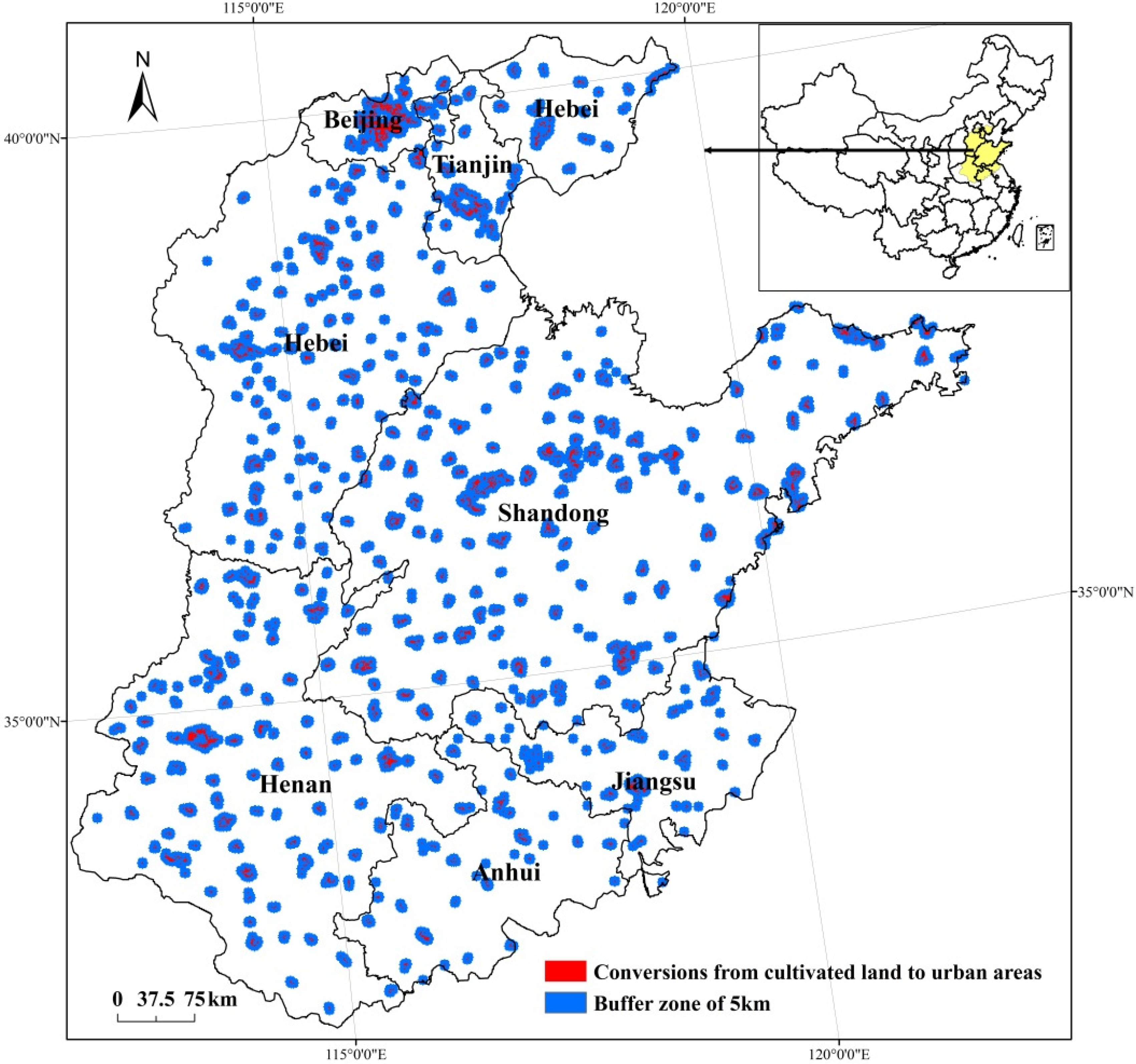
2.2. Data Sources
3. Methodology
3.1. NPP-Based Ecosystem Service Model
| Ecosystem service | Data requirements |
|---|---|
| Organic material production | NPP, the conversion coefficient from biochar to organic material, price of standard coal |
| Nutrient cycling | NPP, distribution rate of nutrient elements in organic material, conversion coefficients of nutrient elements to corresponding chemical fertilizer, price of chemical fertilizer, land use map |
| Soil conservation | Digital elevation model, precipitation, soil texture, soil organic carbon, soil nutrients, soil density, soil thickness, cost of reservoir construction, vegetation coverage, economic benefit of forest planting, price of chemical fertilizer, land use map |
| Water conservation | Precipitation, actual evapotranspiration, cost of reservoir construction, ratio of runoff generated from precipitation, the coefficient of reducing runoff compared to bare land, cost of reservoir construction, land use map |
| Gas regulation | NPP, parameter of absorbing carbon dioxide when producing 1 g dry matter, parameter of producing oxygen when producing 1 g dry matter |
3.2. Buffer Comparison Method
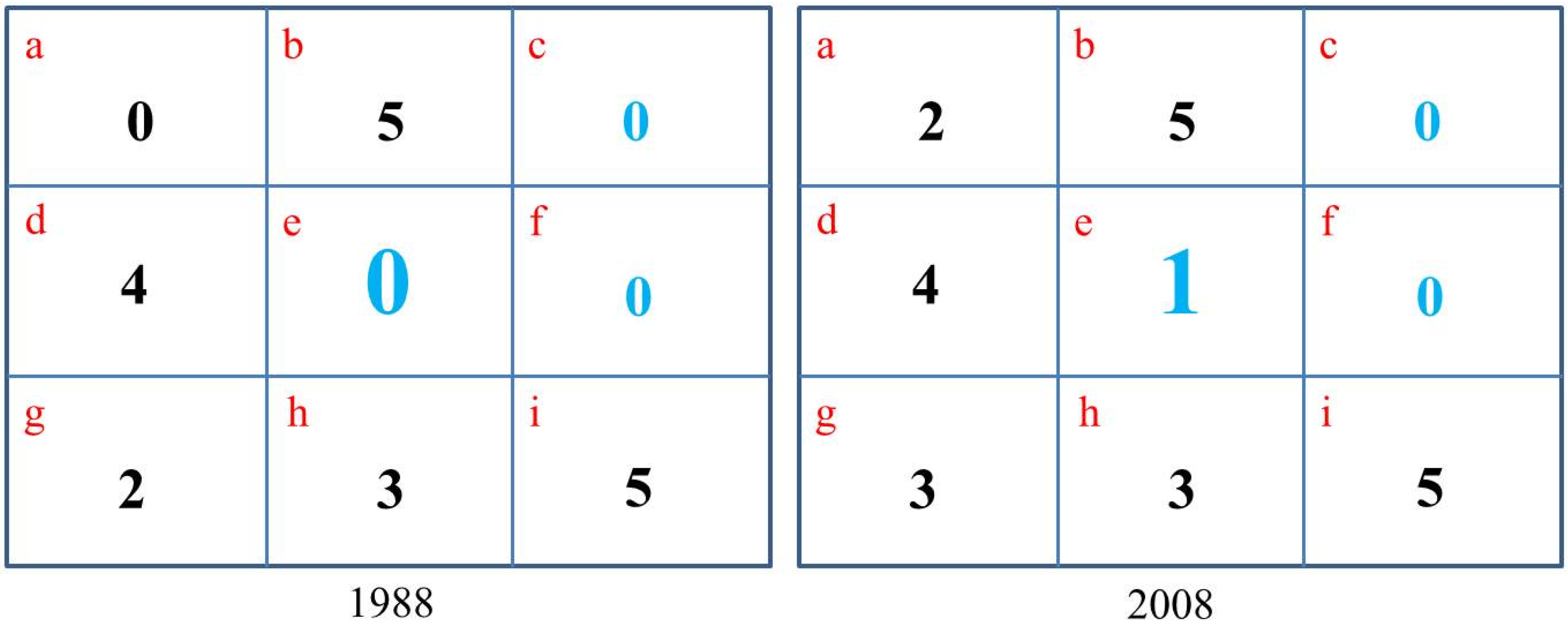
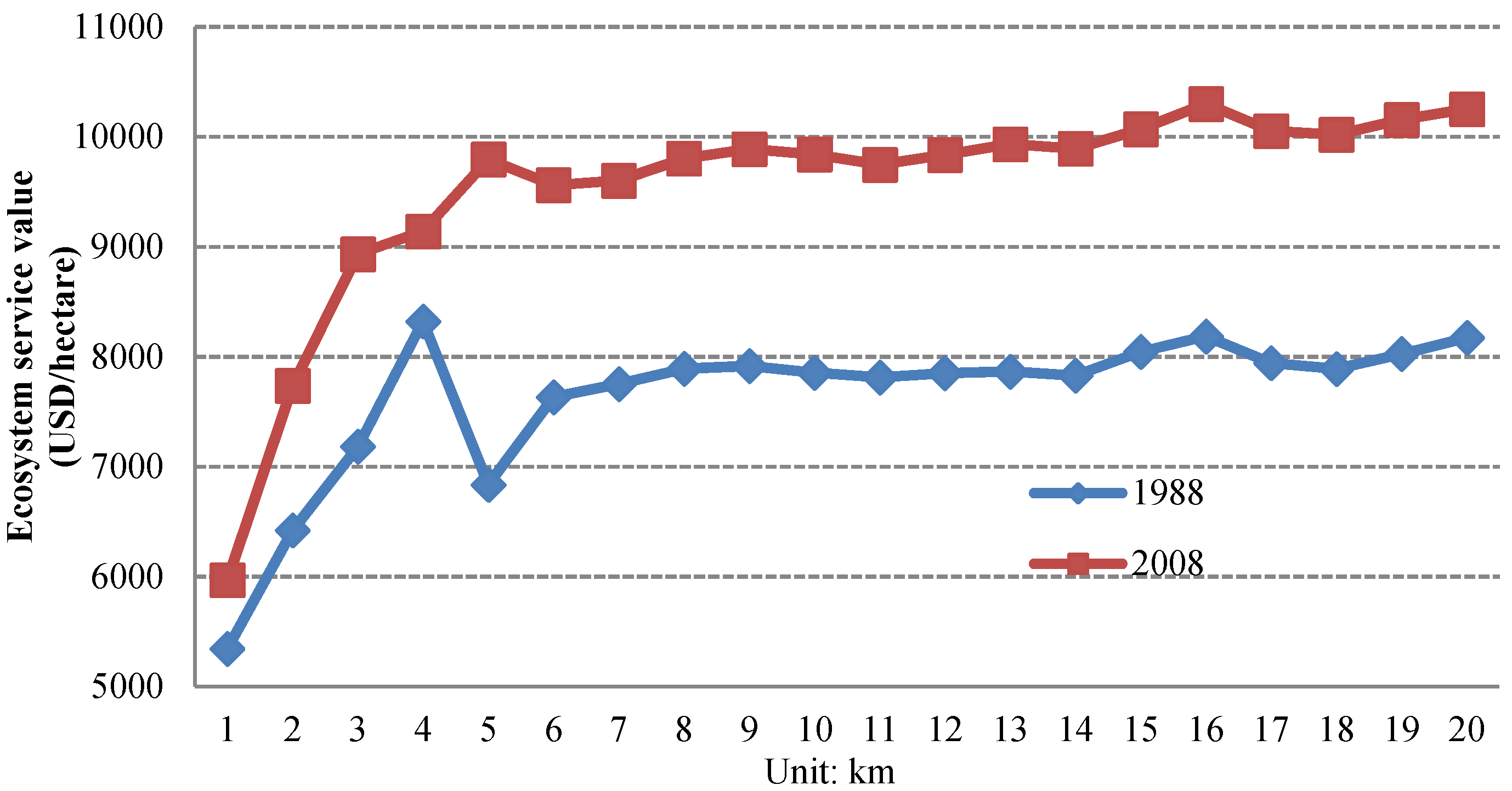
3.3. Assessments of Contributions of Land Use and Climate Change in Driving ESV Change
3.4. Urban Expansion Rate and Cultivated Land Loss Ratio in Urban Expansion
4. Results
4.1. Cultivated Land Loss Due to Urbanization in the NCP
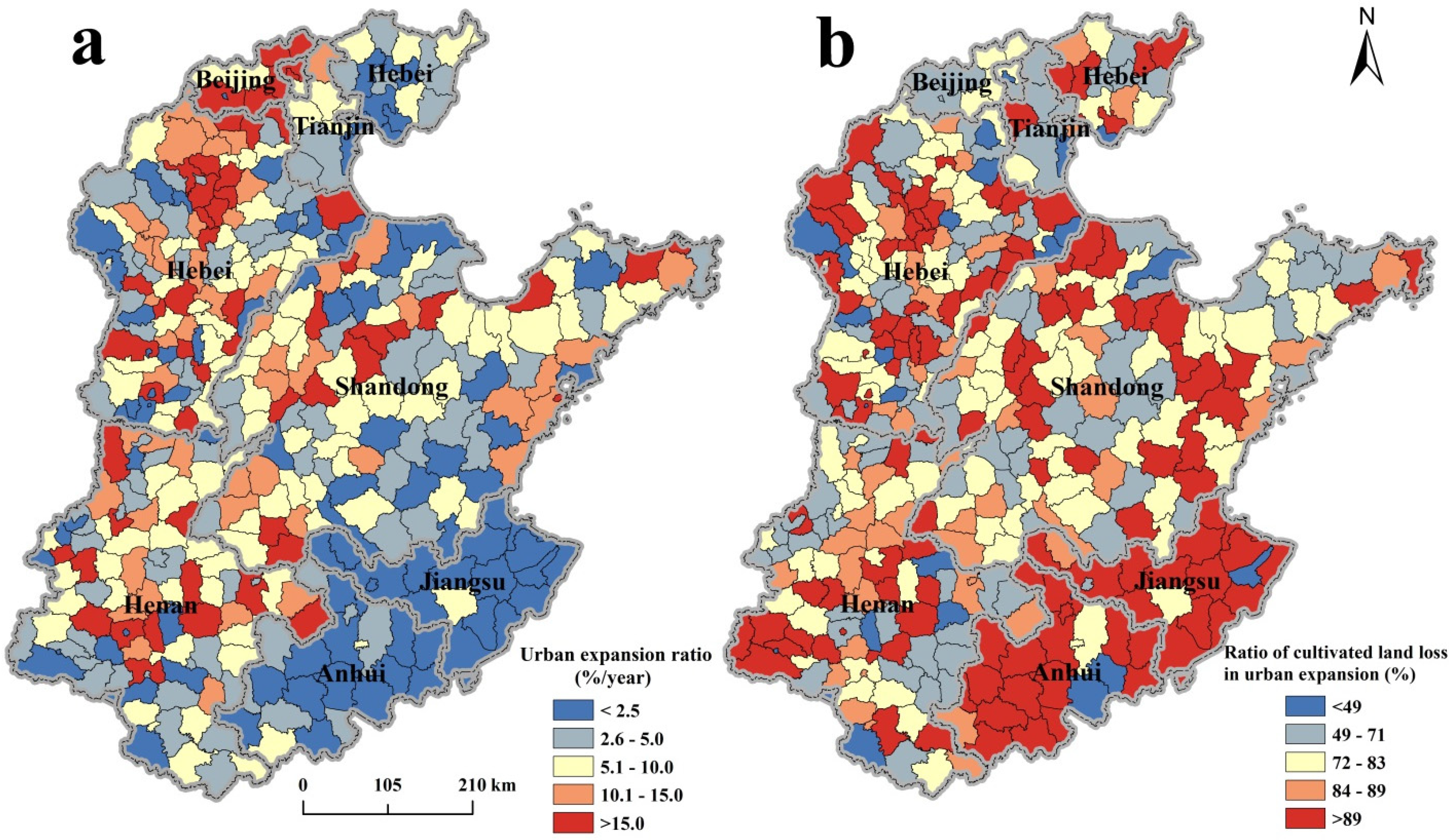
4.2. Actual Changes in ESV in the Conversions from Cultivated Land to Urban Areas
| Ecosystem service | ESV in (USD/ha) | Value change (USD/ha) | Change percentage (%) | |
|---|---|---|---|---|
| 1988 | 2008 | |||
| Total ecosystem service | 3911.17 | 3561.84 | −349.33 | −8.94 |
| Nutrient cycling | 12.33 | 10.96 | 1.37 | −3.18 |
| Water conservation | 890.46 | 0.00 | −890.46 | −100.00 |
| Gas regulation | 613.73 | 746.62 | 132.88 | 21.54 |
| Organic production | 2001.48 | 2431.64 | 431.53 | 21.54 |
| Soil conservation | 393.17 | 372.62 | −20.55 | −5.50 |
4.3. Effects of Land Use Change on ESV
| Ecosystem service | Actual change (%) | Effects of climate change (%) | Effects of land use change (%) |
|---|---|---|---|
| Total ecosystem service | −8.94 | 25.72 | −34.66 |
| Nutrient cycling | −3.18 | 28.73 | −31.91 |
| Water conservation | −100.00 | 24.03 | −124.03 |
| Gas regulation | 21.54 | 28.73 | −7.18 |
| Organic production | 21.54 | 28.73 | −7.18 |
| Soil conservation | −5.50 | −7.90 | 2.40 |
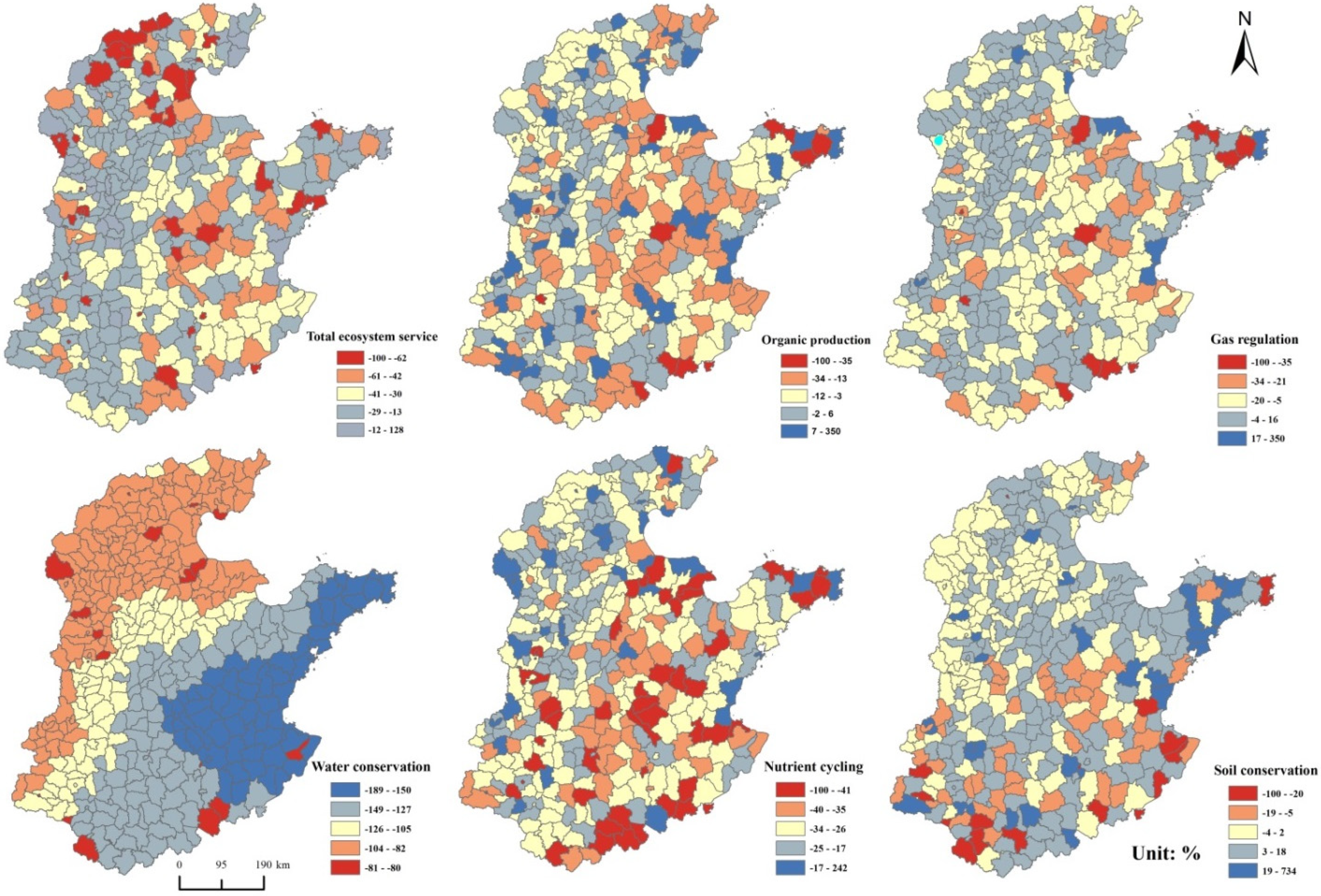
4.4. Contributions of Land Use and Climate Change in Driving ESV Change
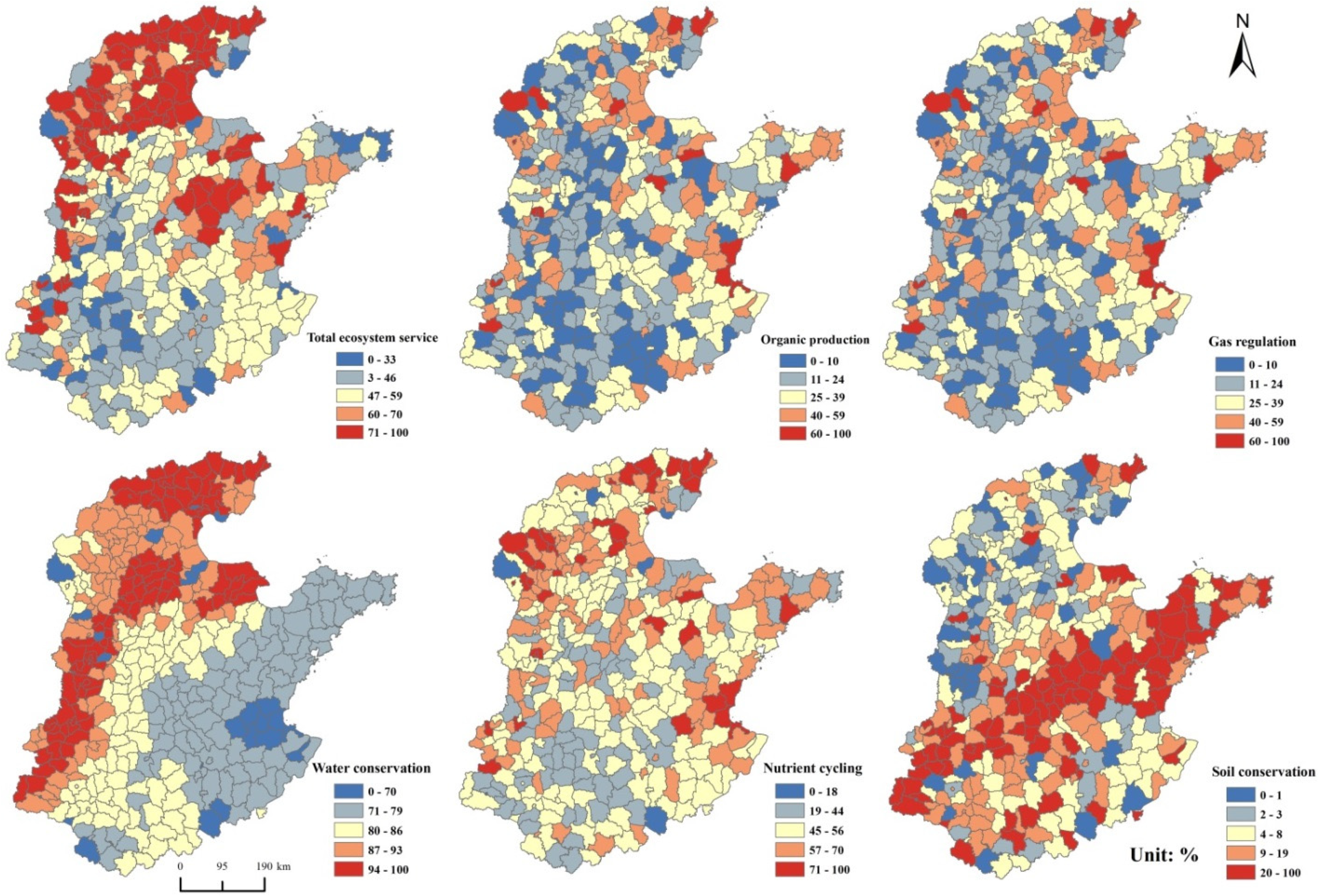
5. Discussion
5.1. Causes of the Changes in Ecosystem Service in the Process of Urbanization
5.2. Comparisons between the Buffer and Other Previous Methods
5.3. Uncertainty of the Assessment
6. Conclusions
Acknowledgments
Author Contributions
Conflicts of Interest
References
- Seto, K.C.; Reenberg, A.; Boone, C.G.; Fragkias, M.; Haase, D.; Langanke, T.; Marcotullio, P.; Munroe, D.K.; Olah, B.; Simon, D. Urban land teleconnections and sustainability. Proc. Natl. Acad. Sci. USA 2012, 109, 7687–7692. [Google Scholar] [CrossRef] [PubMed]
- Song, W.; Pijanowski, B.C.; Tayyebi, A. Urban expansion and its consumption of high-quality farmland in Beijing, China. Ecol. Indic. 2015, 54, 60–70. [Google Scholar] [CrossRef]
- United Nations. World Urbanization Prospects, the 2011 Revision; United Nations: New York, NY, USA, 2012. [Google Scholar]
- Haase, D.; Frantzeskaki, N.; Elmqvist, T. Ecosystem services in urban landscapes: Practical applications and governance implications. Ambio 2014, 43, 407–412. [Google Scholar] [CrossRef] [PubMed]
- Xu, T.; Ma, T.; Zhou, C.H.; Zhou, Y.K. Characterizing spatio-temporal dynamics of urbanization in China using time series of DMSP/OLS night light data. Remote Sens. 2014, 6, 7708–7731. [Google Scholar] [CrossRef]
- Song, W.; Liu, M.L. Assessment of decoupling between rural settlement area and rural population in China. Land Use Policy 2014, 39, 331–341. [Google Scholar] [CrossRef]
- Tayyebi, A.; Pijanowski, B.C. Modeling multiple land use changes using ANN, CART and MARS: Comparing tradeoffs in goodness of fit and explanatory power of data mining tools. Int. J. Appl. Earth Obs. 2014, 28, 102–116. [Google Scholar] [CrossRef]
- Ntelekos, A.A.; Oppenheimer, M.; Smith, J.A.; Miller, A.J. Urbanization, climate change and flood policy in the United States. Climatic Change 2010, 103, 597–616. [Google Scholar] [CrossRef]
- Song, W. Decoupling cultivated land loss by construction occupation from economic growth in Beijing. Habitat Int. 2014, 43, 198–205. [Google Scholar] [CrossRef]
- Shen, L.Y.; Zhou, J.Y. Examining the effectiveness of indicators for guiding sustainable urbanization in China. Habitat Int. 2014, 44, 111–120. [Google Scholar] [CrossRef]
- National Bureau of Statistics of the People’s Republic of China. China Statistical Yearbook 2014; China Statistics Press: Beijing, China, 2014.
- Zang, S.Y.; Wu, C.S.; Liu, H.; Na, X.D. Impact of urbanization on natural ecosystem service values: A comparative study. Environ. Monit. Assess. 2011, 179, 575–588. [Google Scholar] [CrossRef] [PubMed]
- Zhang, K.H.; Song, S.F. Rural-urban migration and urbanization in China: Evidence from time-series and cross-section analyses. China Econ. Rev. 2003, 14, 386–400. [Google Scholar] [CrossRef]
- Song, W.; Pijanowski, B.C. The effects of China’s cultivated land balance program on potential land productivity at a national scale. Appl. Geogr. 2014, 46, 158–170. [Google Scholar] [CrossRef]
- Tayyebi, A.; Pijanowski, B.C.; Linderman, M.; Gratton, C. Comparing three global parametric and local non-parametric models to simulate land use change in diverse areas of the world. Environ. Modell. Softw. 2014, 59, 202–221. [Google Scholar] [CrossRef]
- Tayyebi, A.; Pijanowski, B.C.; Pekin, B.K. Land use legacies of the Ohio River Basin: Using a spatially explicit land use change model to assess past and future impacts on aquatic resources. Appl. Geogr. 2015, 57, 100–111. [Google Scholar] [CrossRef]
- Seto, K.C.; Fragkias, M.; Guneralp, B.; Reilly, M.K. A meta-analysis of global urban land expansion. PLoS ONE 2011, 6, e23777. [Google Scholar] [CrossRef] [PubMed]
- Angel, S.; Parent, J.; Civco, D.L.; Blei, A.; Potere, D. The dimensions of global urban expansion: Estimates and projections for all countries, 2000–2050. Prog. Plann. 2011, 75, 53–107. [Google Scholar] [CrossRef]
- Tan, M.H.; Li, X.B.; Lu, C.H. Urban land expansion and arable land loss of the major cities in China in the 1990s. Sci. China Ser. D 2005, 48, 1492–1500. [Google Scholar] [CrossRef]
- Chen, J. Rapid urbanization in China: A real challenge to soil protection and food security. Catena 2007, 69, 1–15. [Google Scholar] [CrossRef]
- Rebele, F. Urban ecology and special features of urban ecosystems. Global Ecol. Biogeogr. 1994, 4, 173–187. [Google Scholar] [CrossRef]
- Su, Z.M.; Zhang, R.Z.; Qiu, J.X. Decline in the diversity of willow trunk-dwelling weevils (Coleoptera: Curculionoidea) as a result of urban expansion in Beijing, China. J. Insect. Conserv. 2011, 15, 367–377. [Google Scholar] [CrossRef]
- Zapata, V.M.; Robledano, F. Assessing biodiversity and conservation value of forest patches secondarily fragmented by urbanisation in semiarid southeastern Spain. J. Nat. Conserv. 2014, 22, 166–175. [Google Scholar] [CrossRef]
- Heterick, B.E.; Lythe, M.; Smithyman, C. Urbanisation factors impacting on ant (Hymenoptera: Formicidae) biodiversity in the Perth metropolitan area, Western Australia: Two case studies. Urban Ecosyst. 2013, 16, 145–173. [Google Scholar] [CrossRef]
- Arola, T.; Korkka-Niemi, K. The effect of urban heat islands on geothermal potential: Examples from Quaternary aquifers in Finland. Hydrogeol. J. 2014, 22, 1953–1967. [Google Scholar] [CrossRef]
- Zhao, L.; Lee, X.; Smith, R.B.; Oleson, K. Strong contributions of local background climate to urban heat islands. Nature 2014, 511, 216–219. [Google Scholar] [CrossRef] [PubMed]
- Christ, K.; Baier, K.; Schmitz, K.S.; Jha, R.; Azzam, R. Water pollution and environmental problems as a result of urbanization in Hyderabad. Wasserwirtschaft 2012, 102, 25–30. [Google Scholar] [CrossRef]
- He, H.M.; Zhou, J.; Wu, Y.J.; Yu, Q.; Zhang, W.C.; Xie, X.P. Estimating water quality pollution impacts based on economic loss models in urbanization process in Xi’an, China. J. Urban Plan. Dev. 2007, 133, 151–160. [Google Scholar] [CrossRef]
- Aunan, K.; Wang, S.X. Internal migration and urbanization in China: Impacts on population exposure to household air pollution (2000–2010). Sci. Total. Environ. 2014, 481, 186–195. [Google Scholar] [CrossRef] [PubMed]
- Cumming, G.S.; Buerkert, A.; Hoffmann, E.M.; Schlecht, E.; von Cramon-Taubadel, S.; Tscharntke, T. Implications of agricultural transitions and urbanization for ecosystem services. Nature 2014, 515, 50–57. [Google Scholar] [CrossRef] [PubMed]
- Jat, M.K.; Khare, D.; Garg, P.K.; Shankar, V. Remote sensing and GIS-based assessment of urbanisation and degradation of watershed health. Urban Water J. 2009, 6, 251–263. [Google Scholar] [CrossRef]
- Deng, X.Z.; Zhao, C.H.; Lin, Y.Z.; Zhang, T.; Qu, Y.; Zhang, F.; Wang, Z.; Wu, F. Downscaling the impacts of large-scale lucc on surface temperature along with IPCC RCPs: A global perspective. Energies 2014, 7, 2720–2739. [Google Scholar] [CrossRef]
- Ma, E.J.; Deng, X.Z.; Zhang, Q.; Liu, A.P. Spatial variation of surface energy fluxes due to land use changes across China. Energies 2014, 7, 2194–2206. [Google Scholar] [CrossRef]
- Deng, X.Z.; Han, J.Z.; Yin, F. Net energy, co2 emission and land-based cost-benefit analyses of jatropha biodiesel: A case study of the Panzhihua region of Sichuan province in China. Energies 2012, 5, 2150–2164. [Google Scholar] [CrossRef]
- Long, H.L.; Liu, Y.Q.; Hou, X.G.; Li, T.T.; Li, Y.R. Effects of land use transitions due to rapid urbanization on ecosystem services: Implications for urban planning in the new developing area of China. Habitat Int. 2014, 44, 536–544. [Google Scholar] [CrossRef]
- Su, S.L.; Li, D.L.; Hu, Y.N.; Xiao, R.; Zhang, Y. Spatially non-stationary response of ecosystem service value changes to urbanization in Shanghai, China. Ecol. Indic. 2014, 45, 332–339. [Google Scholar] [CrossRef]
- Lin, T.; Xue, X.Z.; Shi, L.Y.; Gao, L.J. Urban spatial expansion and its impacts on island ecosystem services and landscape pattern: A case study of the island city of Xiamen, Southeast China. Ocean Coast. Manag. 2013, 81, 90–96. [Google Scholar] [CrossRef]
- Hoyer, R.; Chang, H.J. Assessment of freshwater ecosystem services in the Tualatin and Yamhill basins under climate change and urbanization. Appl. Geogr. 2014, 53, 402–416. [Google Scholar] [CrossRef]
- Harmackova, Z.V.; Vackar, D. Modelling regulating ecosystem services trade-offs across landscape scenarios in Trebonsko Wetlands Biosphere Reserve, Czech Republic. Ecol. Model. 2015, 295, 207–215. [Google Scholar] [CrossRef]
- Fu, B.; Wang, Y.K.; Xu, P.; Yan, K.; Li, M. Value of ecosystem hydropower service and its impact on the payment for ecosystem services. Sci. Total. Environ. 2014, 472, 338–346. [Google Scholar] [CrossRef] [PubMed]
- Natural Capital Project. Available online: http://www.naturalcapitalproject.org (accessed on 24 April 2015).
- Song, W.; Deng, X.Z.; Yuan, Y.W.; Wang, Z.; Li, Z.H. Impacts of land-use change on valued ecosystem service in rapidly urbanized North China Plain. Ecol. Model. 2015. [Google Scholar] [CrossRef]
- Song, W.; Deng, X.Z.; Liu, B.; Li, Z.H.; Jin, G. Impacts of Grain-for-Green and Grain-for-Blue policies on valued ecosystem services in Shandong Province, China. Adv. Meteorol. 2015. [Google Scholar] [CrossRef]
- Deng, X.Z.; Huang, J.K.; Uchida, E.; Rozelle, S.; Gibson, J. Pressure cookers or pressure valves: Do roads lead to deforestation in China? J. Environ. Econ. Manag. 2011, 61, 79–94. [Google Scholar] [CrossRef]
- Liu, J.Y.; Kuang, W.H.; Zhang, Z.X.; Xu, X.L.; Qin, Y.W.; Ning, J.; Zhou, W.C.; Zhang, S.W.; Li, R.D.; Yan, C.Z.; et al. Spatiotemporal characteristics, patterns, and causes of land-use changes in China since the late 1980s. J. Geogr. Sci. 2014, 24, 195–210. [Google Scholar] [CrossRef]
- Liu, J.Y.; Liu, M.L.; Tian, H.Q.; Zhuang, D.F.; Zhang, Z.X.; Zhang, W.; Tang, X.M.; Deng, X.Z. Spatial and temporal patterns of China’s cropland during 1990–2000: An analysis based on Landsat TM data. Remote Sens. Environ. 2005, 98, 442–456. [Google Scholar] [CrossRef]
- Heubes, J.; Heubach, K.; Schmidt, M.; Wittig, R.; Zizka, G.; Nuppenau, E.A.; Hahn, K. Impact of future climate and land use change on non-timber forest product provision in Benin, West Africa: Linking niche-based modeling with ecosystem service values. Econ. Bot. 2012, 66, 383–397. [Google Scholar] [CrossRef]
- Su, C.H.; Fu, B.J. Evolution of ecosystem services in the Chinese Loess Plateau under climatic and land use changes. Global Planet Change 2013, 101, 119–128. [Google Scholar] [CrossRef]
- Geng, X.L.; Wang, X.S.; Yan, H.M.; Zhang, Q.; Jin, G. Land use/land cover change induced impacts on water supply service in the upper reach of Heihe River Basin. Sustainability 2015, 7, 366–383. [Google Scholar] [CrossRef]
- Briner, S.; Elkin, C.; Huber, R.; Gret-Regamey, A. Assessing the impacts of economic and climate changes on land-use in mountain regions: A spatial dynamic modeling approach. Agric. Ecosyst. Environ. 2012, 149, 50–63. [Google Scholar] [CrossRef]
- Millennium Ecosystem Assessment. Ecosystems and Human Well-Being: Current State and Trends; Island Press: Washington, DC, USA, 2003.
© 2015 by the authors; licensee MDPI, Basel, Switzerland. This article is an open access article distributed under the terms and conditions of the Creative Commons Attribution license (http://creativecommons.org/licenses/by/4.0/).
Share and Cite
Song, W.; Deng, X. Effects of Urbanization-Induced Cultivated Land Loss on Ecosystem Services in the North China Plain. Energies 2015, 8, 5678-5693. https://doi.org/10.3390/en8065678
Song W, Deng X. Effects of Urbanization-Induced Cultivated Land Loss on Ecosystem Services in the North China Plain. Energies. 2015; 8(6):5678-5693. https://doi.org/10.3390/en8065678
Chicago/Turabian StyleSong, Wei, and Xiangzheng Deng. 2015. "Effects of Urbanization-Induced Cultivated Land Loss on Ecosystem Services in the North China Plain" Energies 8, no. 6: 5678-5693. https://doi.org/10.3390/en8065678






